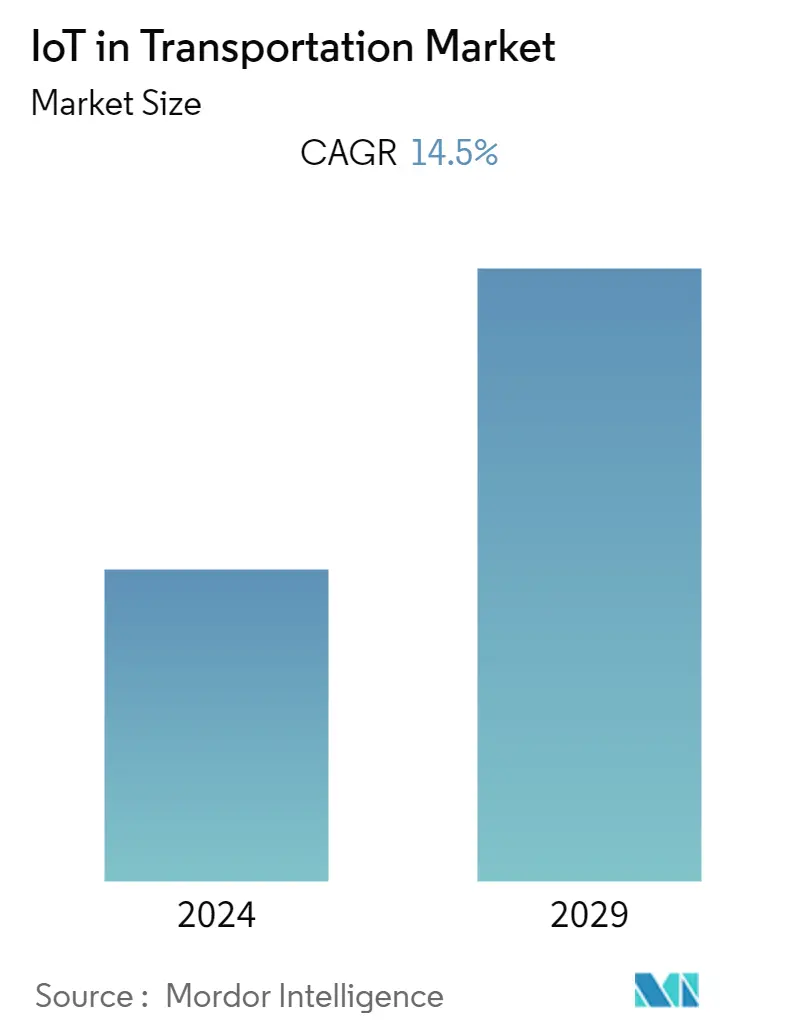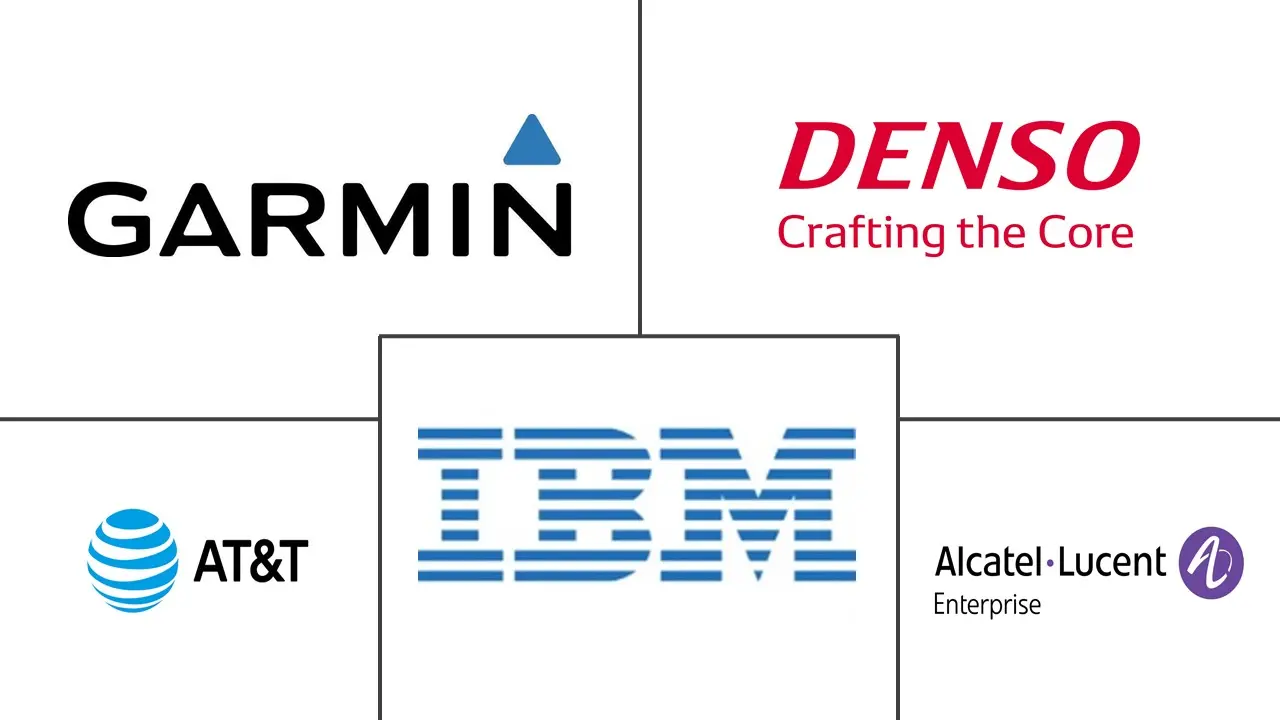Market Size of IoT in Transportation Industry

| Study Period | 2019 - 2029 |
| Base Year For Estimation | 2023 |
| CAGR | 14.50 % |
| Fastest Growing Market | Asia Pacific |
| Largest Market | North America |
| Market Concentration | Low |
Major Players
*Disclaimer: Major Players sorted in no particular order |
IoT in Transportation Market Analysis
The IoT in the transportation market is expected to registering a CAGR of 14.5% over the forecast period of 2021 - 2026. Reduced cost of powerful sensor & controllers, extended and enhanced internet connectivity, rise in growth of information, communication, and technology industry, along with the surge in government initiatives for smart cities are the major factors that drive the growth of the global IoT in transformation market. For example, the United States Department of Transportation is working with car manufacturers to incorporate IoT technology to reduce the occurrence of crashes by 80%.
- Global trends, such as digitization, connectivity, sustainability, energy conservation, and integration of IoT, have led to the advent of the smart railway system. The global population is expected to reach 9.8 billion by 2050, out of which 75% will dwell in cities. Hence, it has become imperative for public agencies to ensure that the transportation sector (specifically the rail network) is geared to meet the growing connectivity needs.
- For instance, considering the case of DHL, one of the largest logistics companies worldwide, in June 2019, the company partnered with ALPS Electric Europe GmbH, a prominent manufacturer of electromechanical devices, and Sigfox, a French-based IoT service provider, to optimize supply chain processes of DHL's German parcel network using asset tracking systems and advanced networked sensors.
- Due to the recent shut down of businesses across the world owing to the influence of Coronavirus is expected to influence the IoT in Transportation market negatively, as prices of chips, sensors and other components used in IoT devices may increase over time due to no production and exhaustion of stocks maintained by the manufacturers in few months on short term basis but in long term transportation and other industries might adopt automation on a large scale which will in turn provide opportunities to IoT.
IoT in Transportation Industry Segmentation
The Internet of Things (IoT) can change the transport industry by transforming how transportation systems gather and make use of data. IoT devices are deployed in traffic congestion control systems, in telematics systems within motor vehicles, in reservation and booking systems used by transport operators, in security and surveillance systems, and in remote vehicle monitoring systems to serve benefits such as enhanced traveler experience, increased safety, reduced energy use and congestion and better operational performance.
| Type | |
| Hardware | |
| Software | |
| Services |
| Mode of Transport | |
| Roadways | |
| Railways | |
| Airways | |
| Maritime |
| Application | |
| Traffic congestion control system | |
| Automotive telematics | |
| Reservation, toll, & ticketing systems | |
| Security and surveillance system | |
| Remote monitoring | |
| Other Applications |
| Geography | ||||||
| ||||||
| ||||||
| ||||||
| Latin America | ||||||
| Middle East and Africa |
IoT in Transportation Market Size Summary
The IoT in transportation market is experiencing significant growth, driven by factors such as the decreasing costs of sensors and controllers, improved internet connectivity, and advancements in the information, communication, and technology sectors. Government initiatives aimed at developing smart cities further bolster this growth. The integration of IoT technologies is transforming transportation systems, particularly in railways, where digitization and connectivity are enhancing operational efficiency and sustainability. Companies like DHL are leveraging IoT for supply chain optimization, while partnerships between tech firms and transportation agencies are fostering innovation. Despite challenges posed by the COVID-19 pandemic, which temporarily disrupted supply chains and increased component costs, the long-term outlook remains positive as industries move towards greater automation.
North America is poised to lead the IoT in transportation market, supported by a robust manufacturing and logistics sector and a strong inclination towards technological adoption. Government bodies in the region are actively promoting IoT solutions through various initiatives, which is expected to drive market expansion. The market is characterized by fragmentation, with numerous global and local players pursuing strategic partnerships and acquisitions to enhance their market presence. Recent collaborations, such as those between Verizon and Audi America, and AT&T and Nokia, highlight the industry's focus on advancing IoT solutions. These developments underscore the dynamic nature of the market, as companies strive to leverage IoT for improved connectivity and operational efficiency in transportation.
IoT in Transportation Market Size - Table of Contents
-
1. MARKET DYNAMICS
-
1.1 Market Overview
-
1.2 Industry Value Chain Analysis
-
1.3 Industry Attractiveness - Porter's Five Forces Analysis
-
1.3.1 Bargaining Power of Suppliers
-
1.3.2 Bargaining Power of Consumers
-
1.3.3 Threat of New Entrants
-
1.3.4 Threat of Substitutes
-
1.3.5 Intensity of Competitive Rivalry
-
-
1.4 Market Drivers
-
1.4.1 Decreased cost of powerful sensors & controllers
-
1.4.2 Extended connectivity and enhanced internet connectivity
-
1.4.3 Government Initiatives for Smart Cities
-
-
1.5 Market Restraints
-
1.5.1 High Initial Cost
-
1.5.2 Threat for data security & privacy
-
1.5.3 Poor transport infrastructure in the developing and underdeveloped nations
-
-
1.6 Assessment of Impact of Covid-19 on the Industry
-
-
2. MARKET SEGMENTATION
-
2.1 Type
-
2.1.1 Hardware
-
2.1.2 Software
-
2.1.3 Services
-
-
2.2 Mode of Transport
-
2.2.1 Roadways
-
2.2.2 Railways
-
2.2.3 Airways
-
2.2.4 Maritime
-
-
2.3 Application
-
2.3.1 Traffic congestion control system
-
2.3.2 Automotive telematics
-
2.3.3 Reservation, toll, & ticketing systems
-
2.3.4 Security and surveillance system
-
2.3.5 Remote monitoring
-
2.3.6 Other Applications
-
-
2.4 Geography
-
2.4.1 North America
-
2.4.1.1 United States
-
2.4.1.2 Canada
-
-
2.4.2 Europe
-
2.4.2.1 United Kingdom
-
2.4.2.2 Germany
-
2.4.2.3 France
-
2.4.2.4 Rest of Europe
-
-
2.4.3 Asia-Pacific
-
2.4.3.1 China
-
2.4.3.2 India
-
2.4.3.3 Japan
-
2.4.3.4 Rest of Asia-Pacific
-
-
2.4.4 Latin America
-
2.4.5 Middle East and Africa
-
-
IoT in Transportation Market Size FAQs
What is the current IoT in Transportation Market size?
The IoT in Transportation Market is projected to register a CAGR of 14.5% during the forecast period (2024-2029)
Who are the key players in IoT in Transportation Market?
Alcatel-Lucent, AT & T Inc., Garmin International Inc., IBM Corporation and Denso Corporation are the major companies operating in the IoT in Transportation Market.

